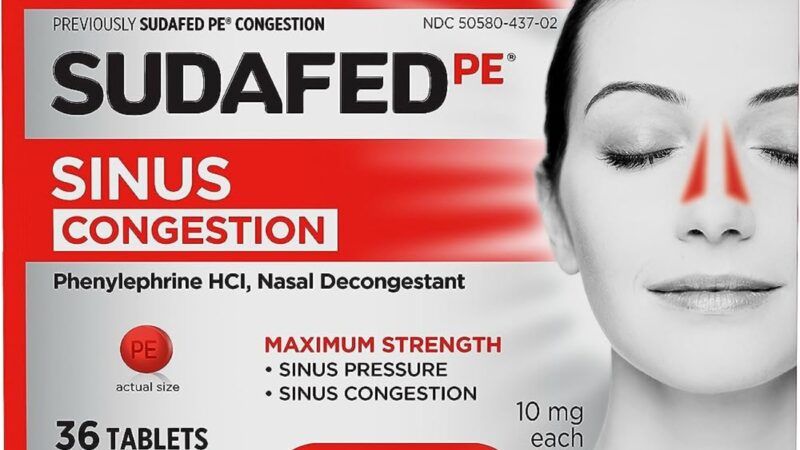Fake Sudafed Is Bullshit, Just As You Suspected
Legal restrictions on pseudoephedrine have not reduced meth use, but they have driven people with colds or allergies toward substitutes that seem to be completely ineffective.

Two decades ago, it became clear that Congress was intent on trying to curtail illicit methamphetamine production by restricting access to pseudoephedrine, a meth precursor that was also widely used as a decongestant in cold and allergy remedies such as Sudafed. Pfizer, the manufacturer of Sudafed products, responded by announcing that it would start selling alternatives containing a different active ingredient: phenylephrine.
What's the difference between pseudoephedrine and phenylephrine? "SUDAFED products with phenylephrine are available for over-the-counter purchase without restrictions," explains Johnson & Johnson, which acquired the brand from Pfizer in 2006, while "products that have pseudoephedrine as an active ingredient face restrictions." Johnson & Johnson does not mention another distinction that might be of interest to consumers: Pseudoephedrine works, while phenylephrine does not. Or so a unanimous panel of experts advised the Food and Drug Administration (FDA) on Tuesday.
The main problem with phenylephrine: When taken orally, it is so thoroughly metabolized in the gut that almost none of it ends up in the bloodstream. "The new data appear compelling that the monographed dosage of oral [phenylephrine] results in no meaningful systemic exposure or evidence of efficacy," says an FDA briefing document that was presented to the advisory committee. "Furthermore, the review suggests that higher doses…have also not shown efficacy. These findings are supported by in vitro and in vivo clinical pharmacology data showing that orally administered phenylephrine undergoes high first-pass metabolism resulting in less than 1% bioavailability."
Legal restrictions on pseudoephedrine sales, in short, gave us reformulated products, including pseudo-Sudafed, that not only do not work as well but apparently do not work at all, as you may have discovered after trying them. But at least those ineffective products are easy to buy.
Legal restrictions on pseudoephedrine, by contrast, took it off the shelves and put it behind the pharmacy counter, whence it can be retrieved only under certain conditions. Thanks to the Combat Methamphetamine Epidemic Act of 2005, Johnson & Johnson notes, "There are limits on the amount of pseudoephedrine that can be purchased at one time and within a month. Purchasers will typically need to present a valid photo ID in order to purchase these products, and the pharmacy is required to record purchases for up to two years."
The federal purchase limit is 3.6 milligrams of pseudoephedrine base in a single day and nine milligrams in a single month. The monthly limit should be enough to keep you covered during allergy season (taking, say, two 12-hour Sudafed pills a day). But the daily limit means you will have to visit the pharmacy repeatedly to obtain your monthly allotment. And if your household includes two or more people who need allergy or cold relief at the same time, each has to buy pills separately. Don't imagine that you'll be allowed to pick up pills for yourself and for your spouse or your child. Inter-store and interstate databases will stop you from completing such a suspicious transaction, which marks you as a probable meth cook or smurfer.
Each state has its own rules for buying pseudoephedrine, which can be stricter than the federal regulations. In Oregon and Mississippi, for example, you can legally obtain the decongestant only by prescription.
These policies have imposed no small amount of inconvenience, snooping, and discomfort on innocent allergy and cold sufferers while treating them as potential criminals. The regulations also have driven many consumers toward less-restricted alternatives that, it turns out, are nothing more than placebos. What benefits can be weighed against those costs?
Restrictions on pseudoephedrine did affect the illicit methamphetamine trade, primarily by shifting production from small-scale U.S. operations toward large-scale Mexican traffickers. But by no means did that crimp the supply. By 2010, The New York Times reported, meth had "reached its highest purity and lowest price in the United States since 2005," when Congress enacted the pseudoephedrine limits.
According to survey data, the number of illegal meth users in the United States more than doubled between 2009 and 2021. And according to a 2023 U.S. Pharmacist report, "age-adjusted rates of drug-overdose deaths per 100,000 population for psychostimulants with abuse potential (primarily methamphetamine) increased from 0.2 in 1999 to 5.0 in 2019." It looks like pseudoephedrine restrictions have been about as effective as phenylephrine pills.


Show Comments (88)